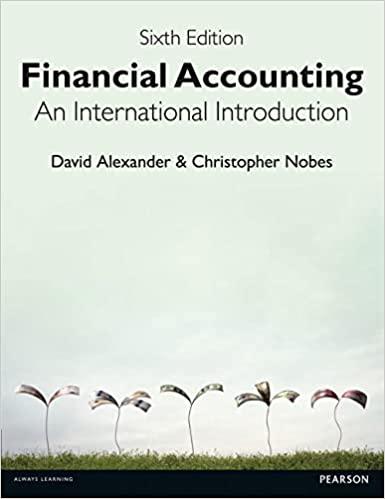Question
QUESTION 1 A recent annual report for Commonwealth Delivery included the following note: NOTE 1: DESCRIPTION OF BUSINESS AND SUMMARY OF SIGNIFICANT ACCOUNTING POLICIES PROPERTY
QUESTION 1
A recent annual report for Commonwealth Delivery included the following note:
NOTE 1: DESCRIPTION OF BUSINESS AND SUMMARY OF SIGNIFICANT ACCOUNTING POLICIES PROPERTY AND EQUIPMENT.
Expenditures for major additions, improvements and flight equipment modifications are capitalized when such costs are determined to extend the useful life of the asset or are part of the cost of acquiring the asset. Expenditures for equipment overhaul costs of engines or airframes prior to their operational use are capitalized as part of the cost of such assets as they are costs required to ready the asset for its intended use. Maintenance and repairs costs are charged to expense as incurred . . .
Assume that Commonwealth Delivery made extensive repairs on an existing building and added a new wing. The building is a garage and repair facility for delivery trucks that serve the Denver area. The existing building originally cost $928,000, and by the end of last year, it was half depreciated based on use of the straight-line method, a 16-year estimated useful life and no residual value. During the current year, the following expenditures related to the building were made:
a. Ordinary repairs and maintenance expenditures for the year, $10,000 cash.
b. Extensive and major repairs to the roof of the building, $141,000 cash. These repairs were completed at the end of the current year.
c. The new wing was completed on December 31 of the current year at a cash cost of $240,000.


QUESTION 2
During the current year, Merkley Company disposed of three different assets. On January 1 of the current year, prior to the disposal of the assets, the accounts reflected the following:

The machines were disposed of during the current year in the following ways:
a. Machine A: Sold on January 1 for $10,500 cash.
b. Machine B: Sold on December 31 for $9,600; received cash, $2,300, and a $7,300 interest-bearing (12 percent) note receivable due at the end of 12 months.
c. Machine C: On January 1, this machine suffered irreparable damage from an accident. On January 10, a salvage company removed the machine at no cost.
Required:
1. Give all journal entries related to the disposal of each machine in the current year. (depreciation and disposal)
a. Machine A.
b. Machine B.
c. Machine C.
2. Explain the accounting rationale for the way that you recorded each disposal.

Required: 1. Applying the policies of Commonwealth Delivery, complete the following, indicating the effects for the preceding expenditures. Indicate the effects positive value for increase, negative value for decrease. Building Accumulated Depreciation Depreciation Expense $ 928,000 $ 464,000 Repairs Expense Cash 928,000 Balance January 1 Depreciation Balance prior to expenditures Expenditure a. Expenditure b. Expenditure c. Balance December 31 2. What was the net book value of the building on December 31 of the current year? Net book value Asset Machine A Machine B Machine C Original Cost $ 42,000 53,000 75, 700 Residual Value $ 3,000 4,000 6,600 Estimated Life 10 years 10 years 16 years Accumulated Depreciation (straight line) $31, 200 (8 years) 39,200 (8 years) 51,825 (12 years) Machine A: Disposal of a long-lived asset with the price below net book value results in a Machine B: Disposal of a long-lived asset with the price above net book value results in a Machine C: Disposal of a long-lived asset due to damage results in a remaining book value
Step by Step Solution
There are 3 Steps involved in it
Step: 1

Get Instant Access to Expert-Tailored Solutions
See step-by-step solutions with expert insights and AI powered tools for academic success
Step: 2

Step: 3

Ace Your Homework with AI
Get the answers you need in no time with our AI-driven, step-by-step assistance
Get Started


